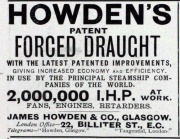Difference between revisions of "James Howden and Co"
| Line 11: | Line 11: | ||
[[Image:Im1915EnV120-p626b.jpg|thumb| 1915. ]] | [[Image:Im1915EnV120-p626b.jpg|thumb| 1915. ]] | ||
[[Image:1918JamesHowden.jpg|thumb| 1918. ]] | [[Image:1918JamesHowden.jpg|thumb| 1918. ]] | ||
[[Image:James Howden and Co 1922ST.jpg|thumb| 1922. ]] | |||
[[Image:Im1926EYB-How.jpg|thumb| 1926. ]] | [[Image:Im1926EYB-How.jpg|thumb| 1926. ]] | ||
Revision as of 19:33, 1 December 2015
James Howden and Co Ltd. of 195, Scotland-Street, Glasgow.
1854 James Howden set up in business as a consulting engineer and designer.
1857 Howden began to design and supply boilers and steam engines for the marine industry.
1860 Howden patented a method of preheating combustion air.
1862, in partnership with James Mathie, Howden purchased land at Scotland Street on the south side of Glasgow, and established the firm of James Howden and Co to manufacture engines and boilers.
1863 Introduced a furnace mechanical draught system using a steam turbine-driven axial flow fan.
1882 Howden patented the "Howden System of Forced Draught" which combined mechanical draught with the transfer of heat from the flue gases to the combustion air.
Shipbuilding was later added to the firm's activities, although the work of hull building was contracted out.
1889 See 1889 Shipbuilding Statistics for detail of the marine engines produced
By 1900 The company was making high-speed engines of the enclosed, forced-lubrication type, which were used chiefly for generating electricity.
1900 Mr James Howden Hulme nephew of James Howden becomes a partner in the company.[1]
1904 Howden began to manufacture steam turbines for use in power generation.
These were followed by the Howden Zoelly impulse type of steam turbine, which the firm supplied to many municipalities, including an installation for the corporation of Manchester.
In 1904 he became involved with another large Glasgow company, James Finlay and Co in a process for curing tea.
1907 Private company.
1909 Developed the Wallsend-Howden oil fired burner.
1912 Water-tube boilers for marine propulsion.
1914 Supplied a 15MW turbo-generator to Manchester Corporation (the largest in the UK).
1923 James Howden and Co of Scotland-street, Glasgow after having made extensive trials at their works of the new Ljungstrom air preheater, acquired a licence for its application to all types of land boilers for England, and held, in addition the exclusive world licence for applying the preheater to marine boilers.[2]
1924 Came into an arrangement with Brown, Boveri and Co of Baden, Switzerland, whereby they become the sole licensees for Great Britain for the manufacture of the Brown-Boveri scavenging blower for two stroke Diesel engines. The blower, as manufactured by James Howden and Co was to be known as the Howden-Brown-Boveri scavenging blower and was to be made entirely to the designs and specification of Brown, Boveri and Co.[3]
1924 the controlling interest in Ruths Steam Accumulator Co, was acquired by the Fairfield Shipbuilding and Engineering Co and James Howden and Co of Glasgow.[4]
1934 Howdens and ICI developed a flue gas desulphurisation (FGD) system for use in power stations.
1938 James Howden & Co Ltd licenced the screw compressor from SRM in Sweden.
1939 Company made public.
1947 Supplied the main blowers for two nuclear reactors at Windscale, UK.
1961 Marine and general engineers. Manufacturers of air preheaters, draught fans, high speed steam engines, rotary screw compressors, dust collecting equipment and flue gas washing plant. Specialists in steel office furniture. 2,649 employees. [5]
1966 World's first submerged gas circulators (for the UK AGR programme).
1968 Acquired Sir George Godfrey and Partners to expand activities in the refrigeration and precision engineering fields.
1973 Howden Group acquired Airscrew Fans from British Match which would add fans that complemented Howden's products and those of its subsidiary Carter Howden[6].
1988 Acquired Davidson and Co, which included Berry, Sturtevant, American Blower, Ventilateurs Neu, and Airtech.
1997 Howden acquired Bryan Donkin Blowers.
1997 Charter plc acquired Howden Group plc.
See Also
Sources of Information
- ↑ The Engineer 1900/01/26 p 106.
- ↑ The Engineer 1923/06/08
- ↑ The Engineer 1924/10/17
- ↑ The Engineer 1924/12/19
- ↑ 1961 Dun and Bradstreet KBE
- ↑ The Times, 13 December 1973
- History of Howden [1]



















